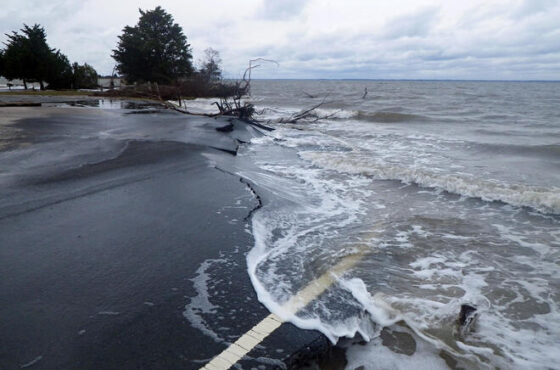Ohio Legislators Are Trying to Undo The State’s Clean Energy Plan
Published by the Natural Resources Defense Fund

WindImages/Flickr
Two years ago, Ohio made a mistake about clean energy.
It’s a correctable mistake, but some are worried that the state is about to dig in its heels—and make things far worse instead.
The story begins in 2008, when a bipartisan majority of legislators approved Ohio’s clean energy standards, bringing the Buckeye State up to speed with other states that had committed themselves to investing in renewables and promoting energy efficiency. The new standards set the year 2025 as an important deadline: By that date, Ohio’s investor-owned utilities were expected to meet 12.5 percent of their electricity demand with power from renewable sources (such as wind, solar, and hydropower), and to have reduced overall electricity usage by at least 22 percent through improved energy efficiency. Success would be measured, in part, by how well the utilities were hitting the annual benchmarks leading to their goals.
A majority of Ohioans supported the law, the governor happily signed it—and almost immediately the standards began reaping economic dividends. Within five years, Ohio could credit those standards with creating thousands of new jobs, spurring $1.3 billion in investment from solar and wind companies, and saving residents more than $1 billion on their electric bills.
And then, just as things were getting really good, Ohio pulled the plug in 2014. The state’s General Assembly passed a new law, SB 310, which temporarily froze the standards for the next two years. The ostensible purpose of this freeze, according to its champions, was to provide a “gut check”—that is, to see if the standards were indeed living up to their initial promise, or whether the people of Ohio had been sold a bill of goods. While the freeze was in place, a “study committee” within the General Assembly would take a long, hard look at the facts, then share its conclusions with the public at a later date.
But others saw the freeze as a stealth move by opponents of renewable energy to dramatically weaken the standards—all under the pretense of ensuring their efficacy, securing jobs, and protecting energy consumers. It’s now looking like their skepticism was merited.
This past spring, as the freeze was entering its home stretch, SB 310’s chief sponsor in the Ohio Senate introduced SB 320: a follow-up bill that would extend the terms of the freeze for another three years. Should it pass, SB 320 will move the goalposts even farther downfield, allowing the state to continue to delay fulfilling its clean energy commitments until 2029. To make matters worse, the bill contains language that would redefine “renewable energy” to include some fossil fuel–based technologies, like so-called clean coal. It would also allow Ohio’s mammoth utilities to compete directly with small, privately owned solar companies, effectively shutting down the solar-power marketplace and “freez[ing] the industry in its tracks,” according to one expert.
Meanwhile, remember that “study committee” formed within the General Assembly? Well, its members have reached their conclusion. And they’re now recommending—surprise, surprise!—that Ohio’s standards be frozen indefinitely.
It’s not hard to see what’s going on. A handful of ideologically motivated legislators who oppose our transition to a clean energy economy are using their considerable political power to sow doubt, stymie progress, and subvert the will of the people. What’s less clear is whether they’ll be allowed to get away with it.
I don’t think they will. There’s simply too much support for moving forward, the direction Ohio had been moving in before the 2014 freeze. And when the General Assembly’s lame-duck session convenes in November to debate extending the freeze, the people of Ohio and the politicians who represent them need to fight back against such blatant cynicism by marshaling evidence that proves the standards really do conserve electricity, save money, and create jobs, all while reducing carbon emissions—and that freezing (or outright eliminating) them is a truly terrible idea. Evidence like the following:
Exhibit A: Researchers at Ohio State University determined that the clean power standards saved ratepayers 1.4 percent on their electricity bills in the five years that they were in place. And as NRDC’s Samantha Williams has pointed out, in addition to the more than $1 billion in savings realized so far, Ohio was on track to save an additional $4 billion over the next decade in avoided energy expenditures. If the standards really do disappear, watch these benefits disappear right along with them.
Exhibit B: Between 2008 and 2012, the Ohio State researchers found, the standards created more than 3,000 new jobs in Ohio as the generation of renewable electricity shot up by more than 60 percent. All in all, Ohio’s clean energy industry employs more than 89,000 people—Ohioans whose livelihoods will be thrown into jeopardy if the industry is allowed to dry up. According to the Brookings Institution, these clean energy jobs pay an average of $3,500 more per year than typical blue-collar jobs annually. Yet opponents of the standards have the audacity to claim that committing to renewable energy is somehow a “job killer.”
Exhibit C: Between 2008 and 2012, while the standards were in effect, greenhouse gas emissions in Ohio declined by nearly 2 percent. According to NRDC’s Williams, reinstating the standards would end up cutting the state’s annual carbon output by nearly 10 million tons between 2017 and 2029—an amount “equivalent to avoiding emissions from the electricity consumed over the course of a year at one million homes.”
Ohioans aren’t dumb. And neither are they gullible. But unless they make their voices heard by telling their legislators that they want to get back on the clean energy path, immediately, they’re going to get the shaft—from some of the very same people who claim to have their best interests at heart.
onEarth provides reporting and analysis about environmental science, policy, and culture. All opinions expressed are those of the authors and do not necessarily reflect the policies or positions of NRDC. Learn more or follow us on Facebook and Twitter.
Read the full article at: https://www.nrdc.org/onearth/ohio-legislators-are-trying-undo-states-clean-energy-plan



